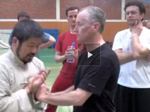My notes from the “Use the Kua to Find the Solid” Zoom lecture.
Power and impact
- The power goes to the non-moving part.
- If you move your kua, it produces power, but if you also move your hand, that power dissipates.
- Moving part generates power; the non-moving part gets impact.
- Like electricity flowing to path of least resistance. It is not something that gets stored, only expressed. (i.e. Energy potential can be stored, power is expressed)
Power conversion
- Everything is a conversion. In everyday life: eat food, digest, do work.
- All physical movement is a conversion; in taiji we want a specific type of conversion.
- In taiji: There is a line between shoulder and the hand. Moving the elbow from right side to the left side across that line (horizontal). Direct the power from that action to the hand so that it gets converted to vertical.
- Auger: Horizontal rotation to going down force.
- One cycle (of life, in Daoism, Buddhism). A cycle of conversion.
- Manipulating power. Changing shape. Converting energy from one form to another. How I can engage you and convert your energy to something else. Neutralize is converting the direction of the opponent’s energy to the earth. Not really absorbing. Like a lightning rod, direct it to a place where it won’t hurt you.
Theory
- The theory must be based on a universal property.
- What we see is an illusion. Based on two things: One is reality, one is perception of reality. Recalibrate so that your perception is as close to reality as possible. To prepare yourself for taiji.
- Aim until there is a close / more direct connection. The standard is always the original object / shape of the universe.
Exercise: Fetching Water with emphasis on the kua
- Most of the time we wiggle the outside, but it never opens up the inside. The ratio between outside and inside is inverted.
- The inside has to make all the move and the outside has to fix (only rotate passively).
- The outside in this move is the knee and shoulder at one point, the foot and head at another.
- Double heavy – every body part likes to follow other body parts. They like to be tied to each other’s movement.
- When the kua opens, the hand likes to swing upward with it instead of staying on the line.
- The elbow is the connection between the kua and the hand. All the movement has to be from the kua.
- Eventually the shoulder goes down, the kua comes up, they match as two arcs that meet on a straight line that goes forward through the fingertips.
- The knee-kua-shoulder is like a bow, the hand-elbow is like an arrow. The bow must hit the arrow and propel it forward.
- It is the momentum of the swing of the arc converted into a straight line. Our tendency is to stop in place (lose all momentum) then try to exert the power as a straight line.
- Tie the elbow to the kua. The shoulder and kua have to aim through the hand. Open until the kua flips over the line of the foot to the head.
- Kua needs to connect to your elbow not your shoulder.
- The head has to line up with the tailbone.
- Elbow, shoulder pair drives hand out. Switches to another pair after: head and hand pair (not sure if my note is correct).
- Once you get the framework, isolate and work on the power to feel the lines.
- Ultimately, three way split.
Clutch
- 著
zhuó/ 捉zhuō? clutch – transmit power from engine to tire.
Shoulder and kua
- Shoulder likes to go upward. We want it to create power by going downward.
- Kua likes to open downward. We want it to open upward.
Flow
- In training: flow goes from foot -> kua -> elbow -> hand.
- In push hands: opponent’s flow goes from hand -> elbow -> kua -> foot.
- Redirect opponent’s touch to the floor. He feels it on his foot, like his feet are floating, so he loses balance.
Usage
- 用法
yòngfǎ, usage. In this training, you restrict yourself to that move to teach yourself how to make it work.- In real fighting (打法
dǎfǎ) you can’t apply this sort of restriction.
- In real fighting (打法
Mirror
- Mirror opponent from below. So that the size is larger than the opponent’s move.
Power hour training
Mistakes I’m making
- Intent on the hand: the hand is anticipating the movement and moving on its own.
- It has to be dead but solid not loose.
- Especially when doing it with speed, the hand’s gear must be locked into the kua and not pop off on its own.
- Shoulder tensing / locking, preventing the arm from staying on the line.
- Makes the hand follow the kua.
- Shoulder needs to match / adjust to kua to make the upper arc.
- Ratio needs to favor the bottom arc.
- Kua starts out with not enough room / too open already.
- Sit back and give the kua space to open, otherwise the movement will be too small – everything else has to be relative to that movement.
Kua drills applied to Yilu forms
- Buddha’s Warrior Pounds Mortar
- When powering up, I tense up my upper arm and move my hand. All the movement has to be on the kua.
- Single Whip
- In the second move, I didn’t have the connection to my elbow. I had to bring the elbow back to the position in Twisting Towel and give more room to my kua.


